FEATURES: ANCIENT STAGECRAFT
And What About Costume?
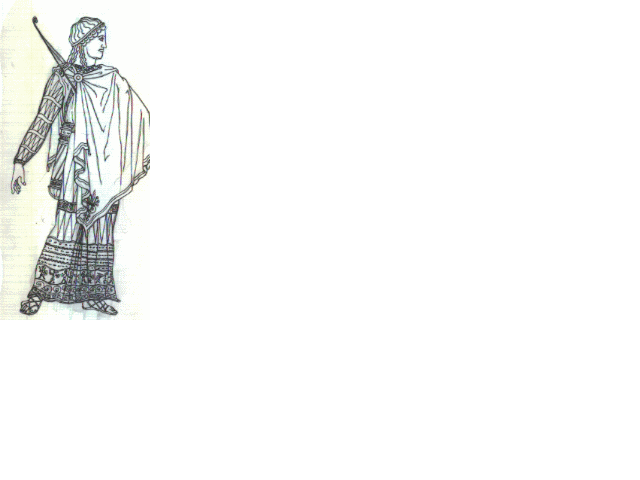
By Sallie Goetsch
Classics and Theatre Studies
University of Warwick
E-mail: tssac@csv.warwick.ac.uk
Costume has received very little attention in the recent and welcome discussions of Greek (and Roman) stagecraft. One reason for this is, of course, lack of direct evidence due to the perishability of the cloth from which those costumes were made. On the other hand, theater is ephemeral by nature, and scholars have managed to make intelligent and convincing inferences about masks, properties, wooden stage buildings, and even stage business and acting techniques on the basis of the indirect evidence found in vase- paintings, sculptures, and literary accounts as well as hands-on reconstructions such as the auloi discussed by Philip Neuman in this issue.
So why, at a time when volumes are being written on aspects of ancient theater about which past scholars have insisted we could say nothing, is there still such silence on the subject of costume? Why has no one, in all this furor to look at ancient culture and ancient literature from new perspectives, started mining this rich and nearly- untapped area of investigation?
Let me advance a hypothesis. Clothing, and in particular an interest in clothing, is generally thought of as a female occupation, and not exactly a liberated one. Even now there are more women costume designers than women set and lighting designers or women directors. The making of clothing has defined women's lives since cloth was invented.
Easy enough, then, for earlier generations of whiteboy scholars to give short shrift to anything they thought of as feminine. Male dismissal of textiles as a field for serious scholarship is not particularly surprising, even today. Even less surprising is the fact that most work done on clothing or costume in antiquity has been done by women--though there are few enough of them. But Iris Brooke's still-valuable treatment of Greek costume, which relies heavily on both Pickard-Cambridge and her own practical investigations, is more than thirty years old. (1) Why have women, too, virtually ignored the subject?

I have suspicions, but no proof. A friend of mine whose lifetime of interest in lace has given her a substantial background in textiles took a course on 'Women in Ancient and Modern Greece' at a highly-respected American university. (All names have been withheld for the protection of your author.) Not surprisingly, she decided to write her final paper on cloth-making traditions down the centuries. Her ideas about textile patterns as a means of communication between women, as links between women in different cultures, as symbolic writing for the illiterate, are fascinating. They become more so when we remember the story of Procne and Philomela.
Iris Brooke's drawings of costumes for Medea
The two instructors of this course were female and not ashamed to be called feminists. My friend found her in-class contributions on the subject of textiles disregarded and her final paper treated dismissively because the subject was not appropriate for a course on women.
What?
We have been looking, obsessively, for the women writers of antiquity, for female rulers, for women who could hold their own in traditionally male preserves. We have also been looking at the social construction of women which men used to justify excluding them from full citizenship. We have looked at marriage and family life, at sexuality, at the division of houses into male and female territory. But on the whole we've had a bit of difficulty getting to grips with women and weaving, beyond noticing that it was what good women were supposed to do. Was the task so common that it has become invisible? Or is it rather that women in academia have wanted to avoid any area of research which might confirm the expectation that it was no use accepting them in graduate programs because they'd just leave to have babies?
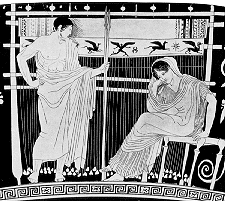
Pattern-weaving as exemplified by Penelope.
Fortunately, there have been exceptions, exceptions which provide solid foundations on which to build an investigation of costume. E.J.W. Barber has done extensive work on the relationships between textile patterns and vase patterns and has analyzed and replicated the technique of pattern-weaving used for elaborately decorated robes such as the peplos woven for Athena.(2) The patterns she describes appear in vase-paintings as the clothing of the gods and the costumes of actors and musicians. The Andromeda vase and the Pronomos vase are both good examples of this.
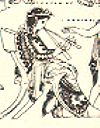 Artist's schematic of the Pronomos Vase.
Artist's schematic of the Pronomos Vase.
 The Andromeda Vase
The Andromeda Vase
The primary objection made to statements that these garments are what fifth-century Athenian actors wore is that the vases in question date to the late fifth and early fourth century and not to the time of Aeschylus nor even to the greater part of Sophocles' or Euripides' careers. While this is a valid objection, there are important points which it does not take into account, the most significant being changes in the conventions of artistic reperesentation.
Late sixth/early fifth-century sculpture is very different from late fifth-century/early fourth-century sculpture. The faces of the korai on the Acropolis are not at all individualistic. We do not see real human beings in those features. Nevertheless, as Mary Stieber has pointed out, Aeschylus could praise sculpture of the sort which surrounded him for its likeness to its subjects. (3) Likeness could be found in small, symbolic details of decoration. Even in later Greek art, which seems much more realistic and naturalistic to the contemporary Western eye, gods and humans were identified not by their faces but by their attributes.
The second argument against concluding that fifth-century theatrical costume looked anything like the Andromeda Vase is that those few extant fragments of fifth-century pottery which do show actors or chorus members show them wearing everyday clothing except for the boots and masks.
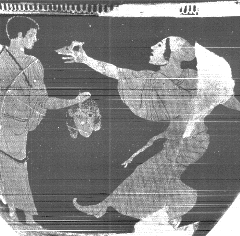
Fifth-century vase-painting of the members of a chorus.
Iris Brooke has already discussed the fact that a woman's chiton is not an appropriate garment for running or dancing in. I can confirm her statement on the basis of personal experience: the drapery of a chiton disarranges easily and if you are not careful you are all too likely to trip over your hem. Women have learned, after lifetimes of practice, to move gracefully in stranger garments (e.g. hoop skirts or high heels), but it is extremely unlikely that the young men of the chorus would be able to keep their clothing intact. (Which leads to some other interesting questions on the whole idea of theatrical 'cross-dressing,' since actors were dressing as women but not, in fact, dressing in women's clothes.)
There is, in other words, a practical reason for the early development of a garment specifically designed for dramatic performers. Unlike athletes, they would not have been well-served by nudity. So why do fifth-century vase-paintings show choreuts in chitons? That, again, is a matter of the conventions of artistic representation. Ceramic decoration, an art which depended less on technology than on an artist's skills, evolved more rapidly than did the forms it represented. Costume design is not a static art with fixed rules, but neither costume nor fashion changed as rapidly in antiquity as it does now. As long as the material had to be produced in the same way, as long as the available raw materials and dyes remained the same, changes in clothing style were likely to be variations on an old theme.
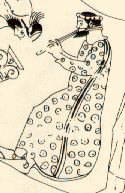 ..
..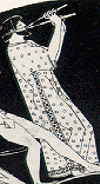 ..
..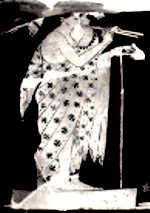 Auletai in costume.
Auletai in costume.
Black-figure representations of auletai in long-sleeved, patterned costumes show that a useful performer's garment evolved quite early on. The fitted garments shown in theatrical vase- paintings of later eras were not an invention of the fifth century. They had long been in existence and were probably taken up by tragedians as soon as the genre was created. Nevertheless these garments are not visible in contemporary representations of theatrical scenes, for the simple reason was that the trend in painting was to illustrate the mythical persons and events which the audience was supposed to infer from the masks and costumes rather than those masks and costumes themselves. As an interest in the fact of performance increased, vase-paintings began to include clear indicators that the figures illustrated were actors in character. (4)
The creation of such a garment is not easy, and it is extremely labor- intensive. If these costumes, which Iris Brooke accepted wholeheartedly for the classical stage, are what actors were wearing, we are left with the question of where they got them. Who made them? Women or girls, as a religious duty and honor, as with the peplos of Athena? Was this the one area in which women made an active contribution to dramatic art? Or was this highly-skilled, potentially lucrative craft the realm of male professionals? Were the weavers citizens or metics? And who paid for an actor's garments, since the choregos was not responsible for outfitting him? Would an actor own more than one such garment at a time? If not, that would make the actor more recognizable in any role and help him to build up a personal following, win more prizes, be offered better roles. Was there an ancient equivalent of a costume designer?
Even 'women's work' can become a male preserve when it is elevated to haute couture or haute cuisine, when it is no longer a necessity but an art. Athenian women may have been excluded from even this entree into the male-dominated world of theatrical performance. A peplos for Athena may have been considered very different from a costume for Dionysus.
But whoever ran it and labored for it, an industry there must have been. Athens abounded in festivals in which performance--music, dance, or drama--played a major part. If an individual garment could take months to make, there would have to be a great many weavers at work to keep up with the demand.
Roman theater is a slightly different question, but one worth asking. The fabulae palliatae of Plautus and Terence may have required only simple tunics and cloaks of the sort which could be bought easily. The very name of the fabulae togatae indicates how the performers were dressed. But what did one wear to perform in a Senecan tragedy (assuming they were performed)? And what did the superstar pantomimes wear? Nothing off the rack, I'm sure.
Professor Norma Goldman of Wayne State University in Detroit, Michigan, has been extensively involved in re-creating Roman fashion as part of a project at the American Academy in Rome. (5) There are plenty of vases illustrating phlyakes comedies in southern Italy and numerous figurines, etc., of Roman actors. A great deal of work has already been done on both Greek and Roman textiles. The wool from which to make a comprehensive investigation of the costume industry has been prepared. Who among us will gather the threads and weave them into coherence?
NOTES:
(1) Iris Brooke, Costume in Greek Classic Drama (Princeton 1962).(2) E.J.W. Barber, Prehistoric Textiles: The Development of Cloth in the Neolithic and Bronze Ages (Princeton University Press 1991); 'The Peplos of Athena,' in Jennifer Neils, Goddess and Polis: The Panathenaic Festival in Ancient Athens, (Princeton University Press and The Trustees of Dartmouth College 1992) 103-117; Women's Work: The first 20,000 years (Norton, 1994).
(3) Mary Stieber, 'Aeschylus' Theoroi and Realism in Greek Art,' TAPA 124 (1994) 85- 119.
(4) Oliver Taplin discusses this at some length in Comic Angels (Clarendon Press, 1993).
(5) Videotape of Norma Goldman's presentation at the Kelsey Museum, Ann Arbor, Michigan, on 1 May 1992: 'Imperial Style: A Roman Fashion show 2nd-1st Century B.C.
Sallie Goetsch
University of Warwick
E-mail: tssac@csv.warwick.ac.uk
(Sallie Goetsch sincerely hopes that one of Didaskalia's readers will pursue this line of research further.)
